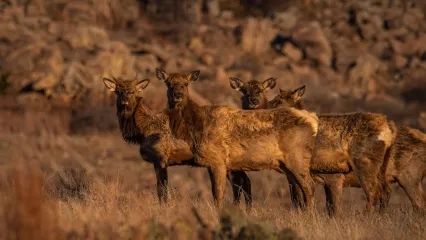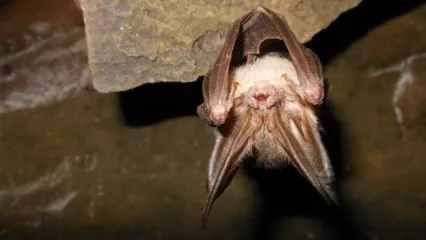
Description
The black-tailed prairie dog (Cynomys ludovicianus) is one of the most social ground squirrels, living communally in large underground networks called "towns." Named for the bark-like warning given when predators are nearby, prairie dogs have an interesting social life, are ecologically important to the prairie ecosystem, and have seen drastic declines since 1900.
Weighing in at two-and-a-half to three pounds, these gregarious rodents are primarily light brown with a black tipped tail. The tan coloration serves as a predator defense; blending in with the habitat allows prairie dogs to escape from hawks circling overhead and coyotes hunting from the ground. Like most rodents, prairie dogs are herbivores, feeding on grasses and annual forbs. This diet keeps the surrounding area clipped, encouraging desired forbs to grow while improving predator detection.
Size
Black-tailed prairie dogs are generally 12-16 inches long and weigh 2-3 pounds.
Habitat
Found in dry, upland shortgrass and mixed-grass prairies, these rodents have well developed forefeet used to dig and maintain their extensive burrows. Entrances to the burrows are typically volcano-shaped and provide ventilation to the system, serve as look out posts, and even help keep water out of the town. Prairie dog towns are surprisingly complicated. Dropping 10-15 feet from the surface of the main entrance, the primary tunnel can extend 50 feet or more in length. Several chambers can be found at the end of secondary tunnels that are used separately for caching food, nesting and even defecation.
Life Cycle
Breeding season is in late winter to early spring with the first litter of four to six pups being born in April. Pups emerge from the burrow six to seven weeks later. While females remain in the town of their birth, males disperse one to two years later to avoid breeding with close relatives.
Prairie dogs are unusually social for rodents, greeting each other by placing their forearms around each other or even touching noses or teeth. Although often incorrectly referred to as hugging, these greetings are in fact a way to identify colony members by smell. The smallest group within a town is called a coterie and consists of a breeding male, three to five females, and several juveniles.
Often referred to ecologically as a keystone species, the importance of prairie dogs in an ecosystem is disproportionate to their abundance. While a prairie dog town may be relatively small, it provides habitat, feeding grounds, and other important areas for several species of wildlife.
One of the largest threats to black-tailed prairie dogs is the sylvatic plague, a disease carried by fleas. Once the plague is introduced to a colony, it spreads quickly, and can cause a drastic decrease in the population within months. Other leading threats come in the form of habitat loss and various control programs. These three factors are responsible for the 90-98 percent population reduction seen in the last 100 years. Regrettably, many people are unaware of the consequences of prairie dog eradication. Completely removing these towns may cause an increase in woody brush and a decrease in overall wildlife diversity.
How To Observe
Some areas, including the Wichita Mountains Wildlife Refuge, have viewing areas. When visiting these towns, it is important to remember these are wild animals. By feeding them human food, you can damage their digestive system and even make them more susceptible to predation.


